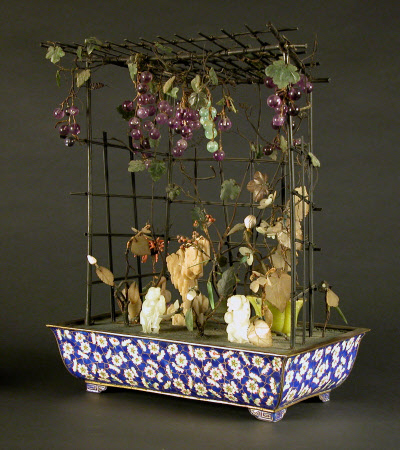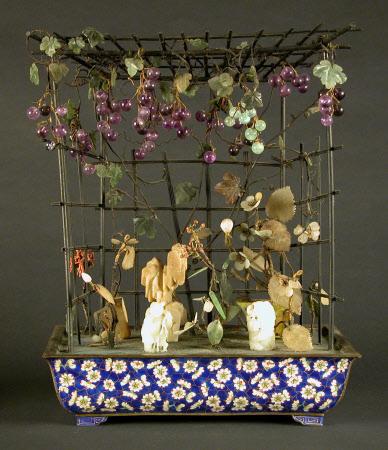Ornamental garden
Category
Objets de vertu
Date
c. 1860 - 1910
Materials
Cloisonné enamel, wood, metal wire, woollen or cotton thread, jade, amethyst, soapstone and coral
Measurements
400 x 315 x 182 mm
Place of origin
Guangzhou
Order this imageCollection
Sissinghurst Castle Garden, Kent
NT 803254.2
Summary
Pair of jardinières or plant containers set with miniature arbours with artificial fruiting grape vines and surrounded by miniature plants, rocks and human figures, Chinese, nineteenth or early twentieth century. The shallow rectangular metal jardinières decorated in cloisonné enamel with a pattern of prunus against a crackled blue ground, the arbour of wood, the vines of metal wire entwined with woollen or cotton thread, the grapes of carved jade and amethyst, the leaves of carved jade, with picturesque rocks of carved soapstone, other flowering plants made of metal wire and various carved stones and coral, and two carved jade figures of playing children.
Full description
Artificial flowering plants and trees and miniature garden vignettes, made of a variety of precious materials and set in decorative jardinières, were popular at the eighteenth-century Qing court, particularly during the reign of the Qianlong Emperor (1736–95). Subsequently they also began to be made for export to the West. The grape vine is symbolic of fecundity and abundance in traditional Chinese art, including an abundance of offspring, which is hinted at by the presence of two figures of children under the arbour. The pattern of prunus on a background of randomly arranged lines is a reference to the practice of displaying branches of prunus in ceramics vessels covered with monochrome, subtly crackled glazes, which was considered a mark of good taste. It was sometimes also interpreted as representing the juxtaposition of flowering prunus trees with cracking ice, suggesting early spring and the return of life as the cold of winter recedes. For the significance of grape vines in Chinese art, see Patricia Bjaaland Welch, Chinese Art: A Guide to Motifs and Visual Imagery, Tokyo, Rutland (Vermont) and Singapore, Tuttle Publishing, 2008, p.53. For the significance of prunus on a crackled ground, see the same source, pp.38–9, and see Jonathan Hay, Sensuous Surfaces: The Decorative Object in Early Modern China, London, Reaktion Books, 2010, p.27. These miniature arbours probably belonged to Victoria, Lady Sackville before being passed to Vita Sackville-West. Two pairs of related jardinières with miniature artificial trees can be seen in a 1912 photograph taken for Country Life magazine of Lady Sackville’s sitting room at Knole, Kent (see Emile de Bruijn, Borrowed Landscapes: China and Japan in the Historic Houses and Gardens of the Britain and Ireland, London, Philip Wilson Publishers in association with the National Trust, 2023, fig.154 (p.219). A somewhat similar miniature arbour was sold at auction at Sotheby’s, New York, 20 November 2020 (The Collection of Ezra & Cecile Zilkha), lot 290.
Provenance
Probably acquired by Victoria, Lady Sackville (1862–1936) and kept at Knole; thought to have been given by Lady Sackville to her daughter, Vita Sackville-West (1892–1962); acquired by HM Government in lieu of inheritance tax and allocated to the National Trust for display at Sissinghurst Castle, 2007.

